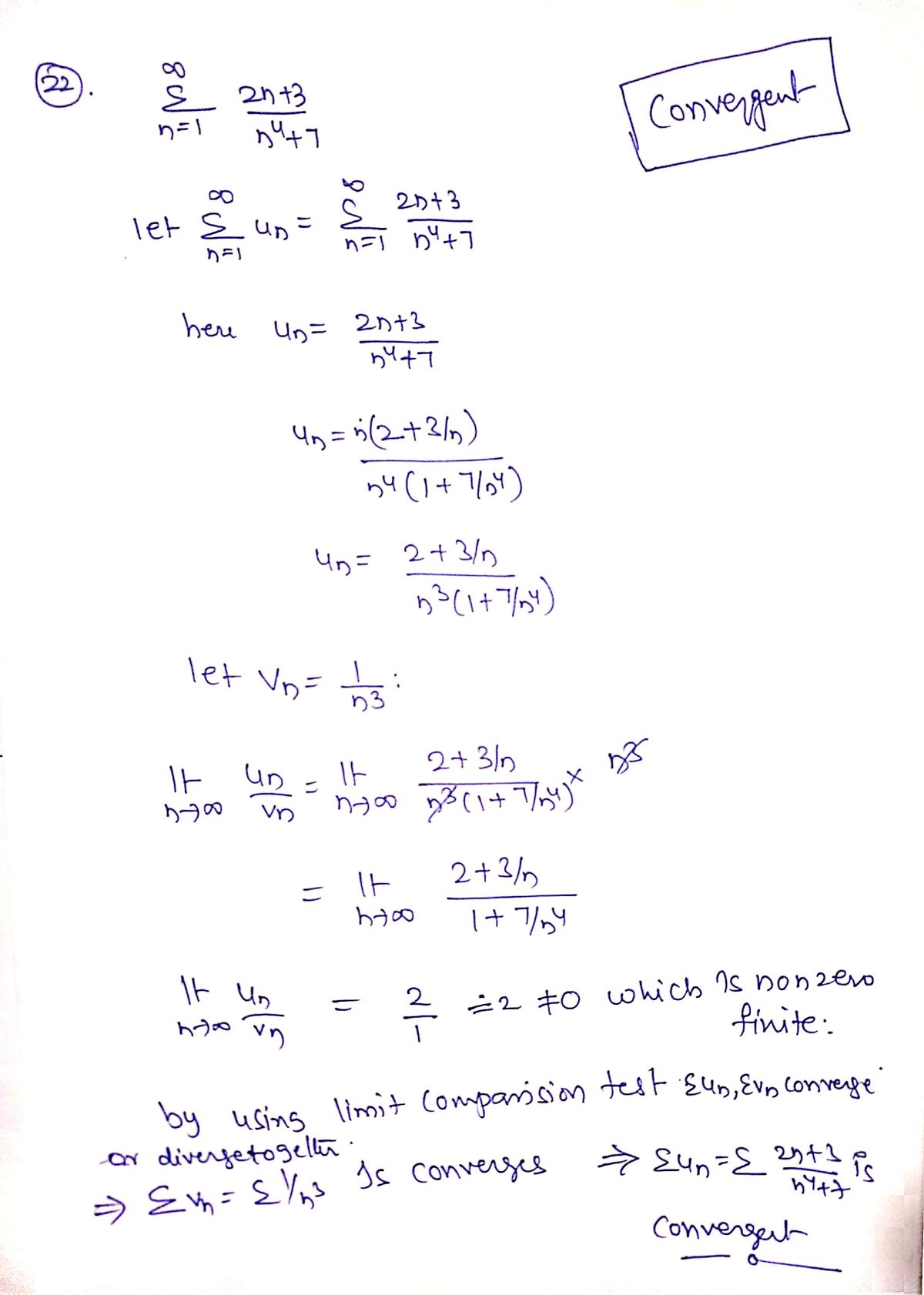2n+3 22. Lm=1 n+7 Using the Limit Comparison Test show if the series is divergent or convergent
2n+3 22. Lm=1 n+7 Using the Limit Comparison Test show if the series is divergent or convergent
Advanced Engineering Mathematics
10th Edition
ISBN:9780470458365
Author:Erwin Kreyszig
Publisher:Erwin Kreyszig
Chapter2: Second-order Linear Odes
Section: Chapter Questions
Problem 1RQ
Related questions
Question
To the 4th power
![**Problem 22:**
Consider the infinite series
\[
\sum_{n=1}^{\infty} \frac{2n+3}{n^4+7}
\]
Using the Limit Comparison Test, determine if the series is divergent or convergent.
**Explanation:**
The Limit Comparison Test involves comparing the given series with another series that is known to converge or diverge. The idea is to select a simpler series, usually a p-series or a geometric series, that resembles the given series for large values of \( n \).
In this case, a suitable choice for comparison might be the series
\[
\sum_{n=1}^{\infty} \frac{1}{n^3}
\]
because \(\frac{2n+3}{n^4+7}\) behaves like \(\frac{1}{n^3}\) as \( n \) becomes very large, due to the highest degree terms in the numerator and denominator.
To apply the Limit Comparison Test, compute:
\[
\lim_{n \to \infty} \frac{\frac{2n+3}{n^4+7}}{\frac{1}{n^3}} = \lim_{n \to \infty} \frac{(2n+3) \cdot n^3}{n^4+7}
\]
Simplify the expression and evaluate the limit. If the limit exists and is a positive finite number, then both series will either converge or diverge together.
Since \(\sum_{n=1}^{\infty} \frac{1}{n^3}\) is a convergent p-series (where \( p = 3 > 1 \)), the original series will also be convergent if the limit is positive and finite.](/v2/_next/image?url=https%3A%2F%2Fcontent.bartleby.com%2Fqna-images%2Fquestion%2F2b937620-31e5-470f-b146-f538889220b0%2F5aaf5110-9da2-473d-9f9f-4005798c353a%2Fa5bfrfq_processed.jpeg&w=3840&q=75)
Transcribed Image Text:**Problem 22:**
Consider the infinite series
\[
\sum_{n=1}^{\infty} \frac{2n+3}{n^4+7}
\]
Using the Limit Comparison Test, determine if the series is divergent or convergent.
**Explanation:**
The Limit Comparison Test involves comparing the given series with another series that is known to converge or diverge. The idea is to select a simpler series, usually a p-series or a geometric series, that resembles the given series for large values of \( n \).
In this case, a suitable choice for comparison might be the series
\[
\sum_{n=1}^{\infty} \frac{1}{n^3}
\]
because \(\frac{2n+3}{n^4+7}\) behaves like \(\frac{1}{n^3}\) as \( n \) becomes very large, due to the highest degree terms in the numerator and denominator.
To apply the Limit Comparison Test, compute:
\[
\lim_{n \to \infty} \frac{\frac{2n+3}{n^4+7}}{\frac{1}{n^3}} = \lim_{n \to \infty} \frac{(2n+3) \cdot n^3}{n^4+7}
\]
Simplify the expression and evaluate the limit. If the limit exists and is a positive finite number, then both series will either converge or diverge together.
Since \(\sum_{n=1}^{\infty} \frac{1}{n^3}\) is a convergent p-series (where \( p = 3 > 1 \)), the original series will also be convergent if the limit is positive and finite.
Expert Solution
Step 1

Step by step
Solved in 2 steps with 1 images

Knowledge Booster
Learn more about
Need a deep-dive on the concept behind this application? Look no further. Learn more about this topic, advanced-math and related others by exploring similar questions and additional content below.Recommended textbooks for you

Advanced Engineering Mathematics
Advanced Math
ISBN:
9780470458365
Author:
Erwin Kreyszig
Publisher:
Wiley, John & Sons, Incorporated

Numerical Methods for Engineers
Advanced Math
ISBN:
9780073397924
Author:
Steven C. Chapra Dr., Raymond P. Canale
Publisher:
McGraw-Hill Education

Introductory Mathematics for Engineering Applicat…
Advanced Math
ISBN:
9781118141809
Author:
Nathan Klingbeil
Publisher:
WILEY

Advanced Engineering Mathematics
Advanced Math
ISBN:
9780470458365
Author:
Erwin Kreyszig
Publisher:
Wiley, John & Sons, Incorporated

Numerical Methods for Engineers
Advanced Math
ISBN:
9780073397924
Author:
Steven C. Chapra Dr., Raymond P. Canale
Publisher:
McGraw-Hill Education

Introductory Mathematics for Engineering Applicat…
Advanced Math
ISBN:
9781118141809
Author:
Nathan Klingbeil
Publisher:
WILEY

Mathematics For Machine Technology
Advanced Math
ISBN:
9781337798310
Author:
Peterson, John.
Publisher:
Cengage Learning,

